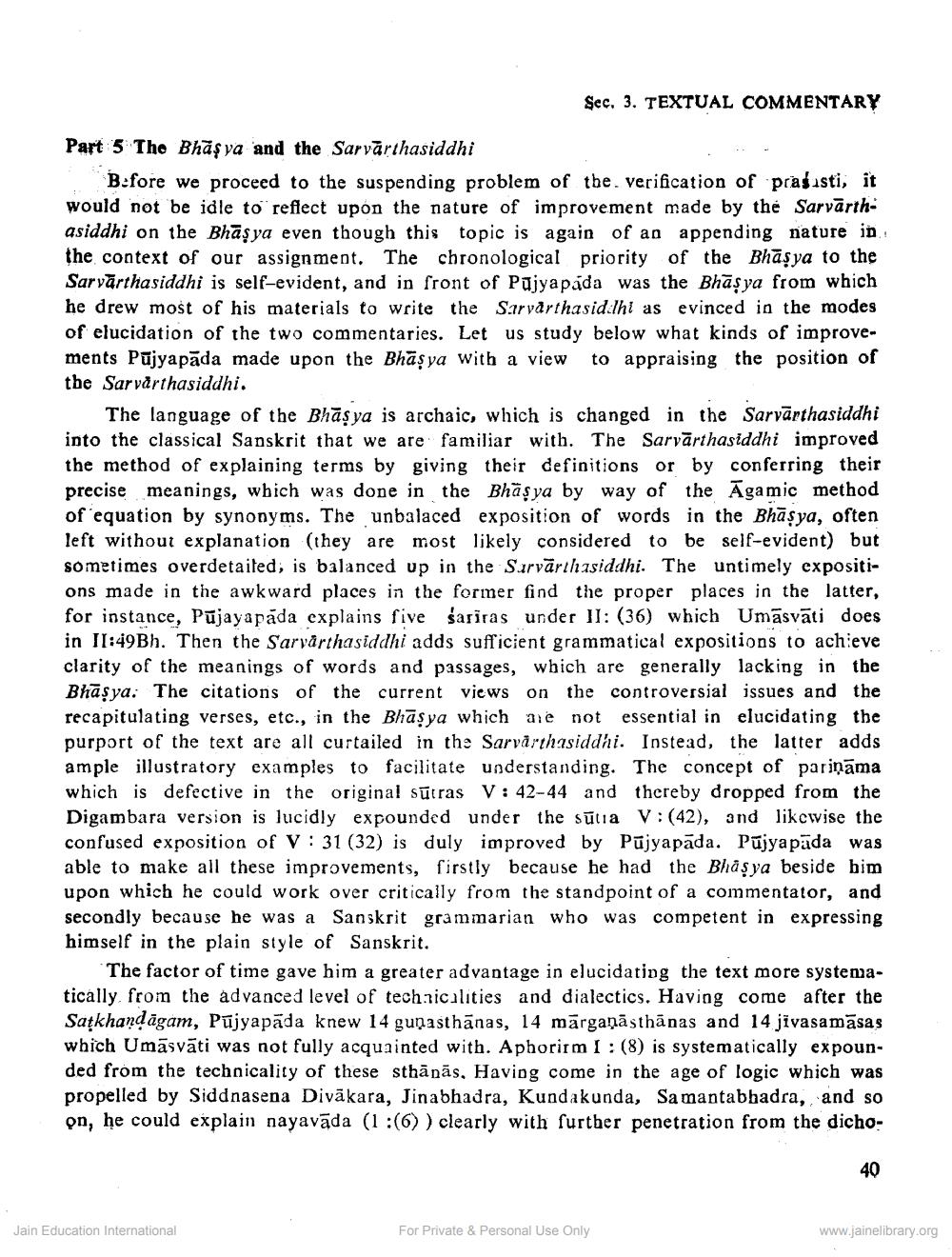________________
Sec. 3. TEXTUAL COMMENTARY
Part 5 The Bhasya and the Sarvarthasiddhi
Before we proceed to the suspending problem of the verification of prasasti, it would not be idle to reflect upon the nature of improvement made by the Sarvarthasiddhi on the Bhasya even though this topic is again of an appending nature in... the context of our assignment. The chronological priority of the Bhasya to the Sarvarthasiddhi is self-evident, and in front of Pujyapada was the Bhasya from which he drew most of his materials to write the Sarvarthasidhi as evinced in the modes of elucidation of the two commentaries. Let us study below what kinds of improvements Pujyapada made upon the Bhasya with a view to appraising the position of the Sarvarthasiddhi.
The language of the Bhasya is archaic, which is changed in the Sarvärthasiddhi into the classical Sanskrit that we are familiar with. The Sarvarthasiddhi improved the method of explaining terms by giving their definitions or by conferring their precise meanings, which was done in the Bhasya by way of the Agamic method of equation by synonyms. The unbalaced exposition of words in the Bhasya, often left without explanation (they are most likely considered to be self-evident) but sometimes overdetailed, is balanced up in the Sarvärthasiddhi. The untimely expositions made in the awkward places in the former find the proper places in the latter, for instance, Pujayapada explains five sariras under 11: (36) which Umasvati does in II:49Bh. Then the Sarvarthasiddhi adds sufficient grammatical expositions to achieve clarity of the meanings of words and passages, which are generally lacking in the Bhasya. The citations of the current views on the controversial issues and the recapitulating verses, etc., in the Bhasya which are not essential in elucidating the purport of the text are all curtailed in the Sarvarthasiddhi. Instead, the latter adds ample illustratory examples to facilitate understanding. The concept of pariņāma which is defective in the original sutras V: 42-44 and thereby dropped from the Digambara version is lucidly expounded under the sutra V: (42), and likewise the confused exposition of V 31 (32) is duly improved by Pujyapada. Pujyapada was able to make all these improvements, firstly because he had the Bhasya beside him. upon which he could work over critically from the standpoint of a commentator, and secondly because he was a Sanskrit grammarian who was competent in expressing himself in the plain style of Sanskrit.
The factor of time gave him a greater advantage in elucidating the text more systematically from the advanced level of technicalities and dialectics. Having come after the Satkhaṇḍāgam, Pujyapada knew 14 gupasthanas, 14 märganästhānas and 14 jivasamāsas which Umasväti was not fully acquainted with. Aphorirm I: (8) is systematically expounded from the technicality of these sthānās, Having come in the age of logic which was propelled by Siddnasena Diväkara, Jinabhadra, Kundakunda, Samantabhadra, and so on, he could explain nayavada (1:(6)) clearly with further penetration from the dicho
Jain Education International
For Private & Personal Use Only
40
www.jainelibrary.org




